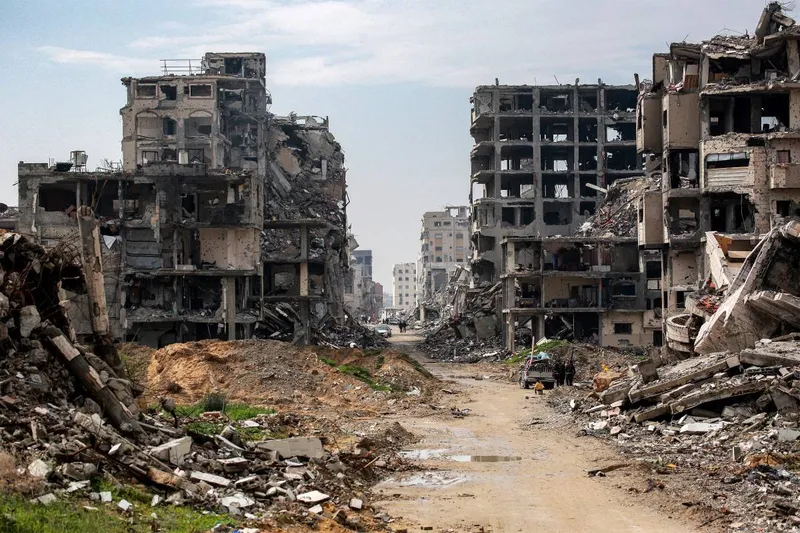More than $50 billion will be needed to rebuild the Gaza Strip following the devastating 15-month conflict between Israel and Hamas, according to a detailed assessment released on Tuesday (18) by a consortium comprising the United Nations, the European Union, and the World Bank. The assessment, titled the Interim Rapid Damage and Needs Assessment (IRDNA), estimates that the recovery and reconstruction of the region will require a total investment of approximately $53.2 billion over the next decade. Of this amount, $20 billion will be needed in the first three years to address the most urgent needs of the population and restore basic infrastructure.
The conflict began on October 7, 2023, when Hamas launched a surprise attack on Israel, resulting in the deaths of 1,200 people and the kidnapping of more than 250 hostages, according to Israeli authorities. In response, Israel launched a massive military offensive in the Gaza Strip, which led to the deaths of more than 48,000 Palestinians, according to estimates from Gaza’s Ministry of Health. The conflict not only claimed thousands of lives but also left an unprecedented trail of destruction, with entire neighborhoods reduced to rubble and millions of people displaced.

Rebuilding the region will be a long, complex, and highly challenging process, involving multiple phases. Initially, the removal of millions of tons of debris from the bombings will be necessary, a task that could take years and will require specialized equipment and skilled labor. Additionally, the presence of unexploded ordnance scattered throughout the territory poses a significant risk to the population’s safety and must be neutralized before any large-scale reconstruction efforts can begin.
The IRDNA report warns that, given the current political and security context, conditions are not yet suitable for initiating structural recovery efforts. Uncertainty over how the enclave will be governed after the conflict and what new security arrangements will be put in place makes it difficult to plan and execute large-scale projects. The document emphasizes that “the speed, scale, and scope of the recovery will be shaped by these conditions.”
According to the assessment, more than 292,000 homes were partially or completely destroyed, leaving hundreds of thousands of people homeless. The healthcare infrastructure was severely affected, with 95% of hospitals and medical units out of operation due to structural damage, medication shortages, and a lack of professionals. Additionally, the local economy suffered a drastic contraction of 83%, impacting all productive sectors, from trade and industry to essential services such as education and healthcare.
Rebuilding buildings and infrastructure—including housing, schools, hospitals, and water and energy supply networks—will require an investment of approximately $29.9 billion. Housing restoration alone will demand around $15.2 billion. Meanwhile, an additional $19.1 billion will be needed to mitigate social and economic losses, ensure labor market recovery, and restore fundamental public services.
The humanitarian crisis in the Gaza Strip is also one of the major challenges to be addressed. The destruction of basic sanitation and water supply infrastructure has left millions of people in precarious conditions, increasing the risk of disease outbreaks and worsening food insecurity. It is estimated that more than 80% of the population is living below the poverty line, relying solely on humanitarian aid to survive. International organizations warn that, without a coordinated and effective response, the situation could deteriorate even further in the coming months.
Beyond logistical and financial challenges, the reconstruction of Gaza will heavily depend on international cooperation and the establishment of a sustainable political agreement that enables the region’s return to normalcy. The report highlights the need for a global commitment to securing the necessary funding and ensuring that resources are used efficiently and transparently.
The World Bank, the UN, and the European Union have reinforced that Gaza’s recovery process will require long-term planning and measures to ensure stability and security—fundamental elements to prevent the region from facing new cycles of destruction and humanitarian crisis. It remains unclear how governance of the territory will be structured after the conflict ends, but experts warn that any solution must address not only physical reconstruction but also the revitalization of the local economy and the protection of fundamental rights for the Palestinian population.
Given this scenario, Gaza’s reconstruction stands as one of today’s greatest challenges, requiring coordinated efforts among governments, international organizations, and humanitarian entities. The region’s future will depend not only on financial investment but also on the international community’s ability to foster a stable and secure environment where the population can rebuild their lives and secure a less uncertain future. Only through a continuous and comprehensive commitment can the current landscape of destruction be transformed into a viable path toward recovery and lasting peace.

